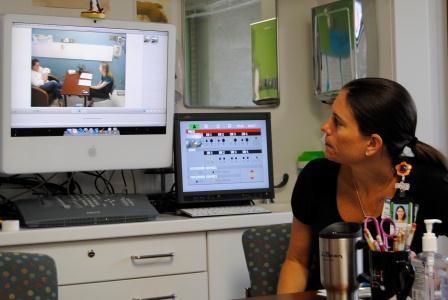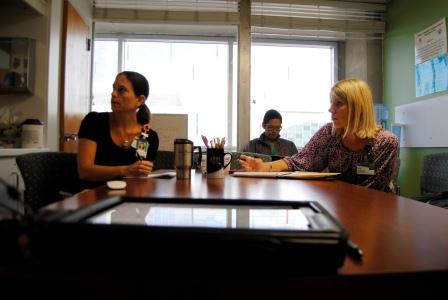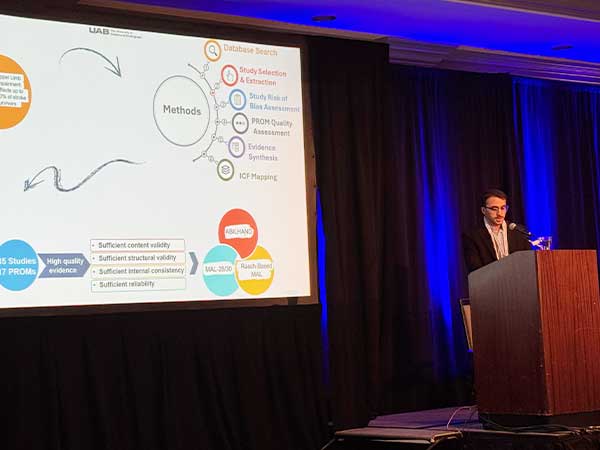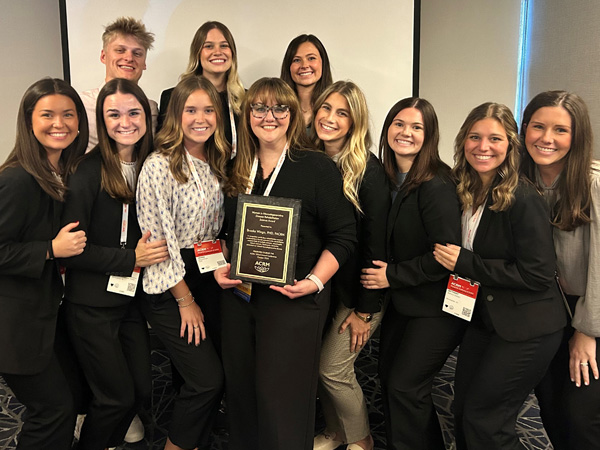 Dawn Taylor Peterson, Ph.D., monitors simulatorSitting in the clinic room alone with her crying baby is a 20-something year old mother. She does not know it, but she is about to be told that her 10-month-old son who is being evaluated for failure to thrive may also have a genetic condition that could lead to additional health and developmental problems in the future.
Dawn Taylor Peterson, Ph.D., monitors simulatorSitting in the clinic room alone with her crying baby is a 20-something year old mother. She does not know it, but she is about to be told that her 10-month-old son who is being evaluated for failure to thrive may also have a genetic condition that could lead to additional health and developmental problems in the future.Delivering the news is a second-year graduate student in the University of Alabama at Birmingham Genetic Counseling Program. This is the first time the student will have the opportunity to deliver this type of abnormal test result during her training as a genetic counselor.
Fortunately for all involved, this is a simulation session where the mother is a standardized patient and the baby is a high-fidelity mannequin. The session provides the genetic counseling class members the opportunity to deliver difficult and complex genetic test information in a realistic, yet supervised environment. Unfortunately, this will not be the last time any of them deliver bad news.
“This scenario and genetic test result is one of the most difficult that a genetic counselor will face,” said Lynn Holt, MS, CGC, who established the UAB GC Program in 2007. “Because of the complexity of the result and the impact that it has on a family, we are hesitant to let students deliver this kind of news during their training. Utilization of simulation scenarios provides the students the opportunity to independently disclose the result and provide the follow up counseling as they will be expected to do when they enter the workforce.”
 Peterson with Lynn Holt, MS, CGC Holt, an assistant professor in the Department of Clinical and Diagnostic Sciences within the School of Health Professions, collaborates with Dawn Taylor Peterson, Ph.D., to facilitate the simulation session and debriefing. Peterson is the Director of Education and Research at the Pediatric Simulation Center at Children’s of Alabama.
Peterson with Lynn Holt, MS, CGC Holt, an assistant professor in the Department of Clinical and Diagnostic Sciences within the School of Health Professions, collaborates with Dawn Taylor Peterson, Ph.D., to facilitate the simulation session and debriefing. Peterson is the Director of Education and Research at the Pediatric Simulation Center at Children’s of Alabama.“We are not judging the students’ performance or giving them a grade, and we are not trying to trick them or make it difficult. This is just for the students’ experience,” said Peterson. “We are providing them with an opportunity to practice what they’ve learned in a setting that replicates a real-life situation.”
The students spend approximately 30 minutes in the room with the mother and her baby. As they deliver the diagnosis and explain the potential ramifications, Holt and Peterson observe via closed circuit television. The simulation session is followed by a 30 minute debriefing that includes the standardized patient playing the mother.
The objective is to provide the student with immediate feedback from everyone’s point of view. Together, the group processes every detail of the experience right down to individual words.
 Pediatric Simulation Center at Children’s of Alabama “I heard you say ‘unfortunately’ several times. In my non-clinician mind, which is different from a genetic counselor’s mind, I think the word ‘unfortunately’ could be perceived as negative or bad,” said Peterson.
Pediatric Simulation Center at Children’s of Alabama “I heard you say ‘unfortunately’ several times. In my non-clinician mind, which is different from a genetic counselor’s mind, I think the word ‘unfortunately’ could be perceived as negative or bad,” said Peterson.The mother in the simulation interpreted the use of the word ‘unfortunately’ in a slightly different way.
“The few times I remember her saying ‘unfortunately’ was when we were discussing that there is not a lot of research available for my child’s case and that to me is unfortunate,” said Casie Carson, a standardized patient, who played the role of the mother.
The simulation sessions are conducted once in the fall semester and once in the spring semester of the second year for the genetic counseling program. Holt and her colleagues’ application of this teaching method, paired with open debriefings, is designed to better prepare students for the reality of working within the field of genetics.
 Software controls baby mannequin behaviorThe simulation component of the program was developed in 2012. The following year Holt and Peterson, along with other faculty and staff from the simulation center, co-authored a paper in the American Journal of Medical Genetics entitled Utilizing High-Fidelity Crucial Conversation Simulation in Genetic Counseling Training.
Software controls baby mannequin behaviorThe simulation component of the program was developed in 2012. The following year Holt and Peterson, along with other faculty and staff from the simulation center, co-authored a paper in the American Journal of Medical Genetics entitled Utilizing High-Fidelity Crucial Conversation Simulation in Genetic Counseling Training.“Our research found that the opportunity for students to run an entire session on their own this early in their training is valuable,” said Holt who was the lead author of the article. “The biggest benefit of simulation is that the students now know what to expect in this type of common scenario and exactly what they can work on during their clinical training to gain confidence and experience as a genetic counselor.”

